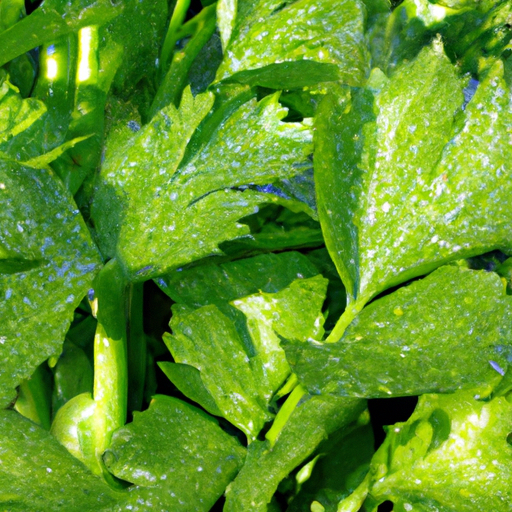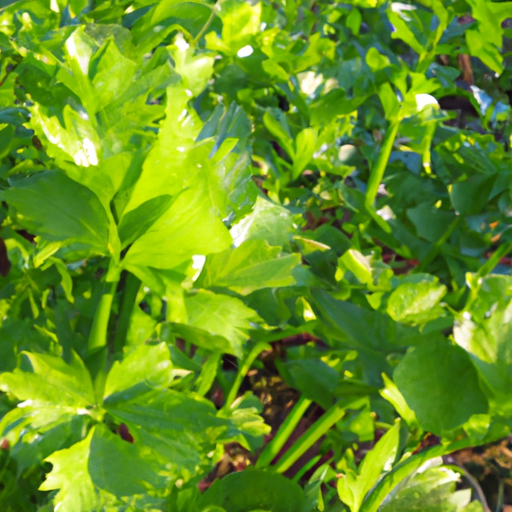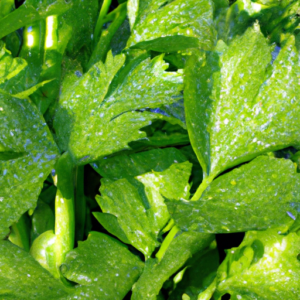Growing celery may seem daunting at first, but with the right knowledge and techniques, you can successfully cultivate this crisp, flavorful vegetable in your own garden. From selecting the right variety and preparing the soil to planting and caring for your celery plants, this article provides a comprehensive guide on how to grow celery. So, whether you’re a seasoned gardener or a beginner, get ready to learn the step-by-step process of growing celery and enjoy the satisfaction of harvesting your very own homegrown stalks.

Choosing the Right Variety
Research Different Varieties
When it comes to growing celery, it’s essential to choose the right variety for your specific needs. Celery varieties can differ in terms of taste, size, and time to maturity. Some popular celery varieties include Tall Utah, Golden Self-Blanching, and Tango. Take the time to research different varieties and consider factors such as flavor preferences and the intended use of your celery.
Consider Climate and Growing Conditions
Another crucial factor to consider when choosing a celery variety is the climate and growing conditions in your area. Celery thrives in moderate to cool climates, with an optimal temperature range of 60 to 70 degrees Fahrenheit (15 to 21 degrees Celsius). Ensure that your chosen variety is suitable for your climate and growing conditions to maximize your chances of success.
Select Disease-Resistant Varieties
Pests and diseases can pose significant challenges to celery plants. To mitigate these risks, it’s a good idea to choose disease-resistant celery varieties. Look for varieties that are resistant to common diseases such as Fusarium wilt and leaf spot. Disease-resistant varieties can help ensure the health and vitality of your celery plants, reducing the need for intensive pest and disease management.
Preparing the Soil
Test the Soil
Before planting celery, it’s essential to test your soil. Soil testing provides valuable information about its nutrient content and pH levels. Celery thrives in slightly acidic to neutral soil, with a pH range of 6.0 to 7.0. Conduct a soil test using a soil testing kit or by sending a sample to a local agricultural extension office. This will help you determine if any adjustments are necessary to create optimal growing conditions for your celery.
Adjust pH Levels
If your soil’s pH levels are not within the ideal range for celery, you may need to make adjustments. To increase acidity, add organic matter such as compost or peat moss. To lower the pH, you can also use amendments such as sulfur. On the other hand, if your soil is too acidic, you can add lime to raise the pH. Adjusting the pH levels will create a favorable environment for celery growth and prevent nutrient deficiencies.
Improve Drainage and Texture
Celery plants require well-draining soil to prevent water saturation, which can lead to root rot. To improve drainage, work organic matter, such as compost or aged manure, into the soil. This will also help improve the soil’s texture, ensuring that it is loose and friable. Loose soil allows roots to penetrate easily and promotes healthy growth, enabling your celery plants to thrive.
Add Organic Matter
Adding organic matter to your soil is an essential step in preparing it for celery cultivation. Organic matter improves soil structure, provides essential nutrients, and encourages beneficial microbial activity. Work compost, well-rotted manure, or other organic materials into the soil before planting. This will enrich the soil, enhancing its fertility and promoting healthy celery growth.
Starting Celery Seeds Indoors
Sow Seeds in Trays or Pots
To give your celery seeds a head start, it’s advisable to start them indoors. Fill trays or pots with a good-quality seed-starting mix, moisten it, and then sow the seeds. Plant the seeds about 1/8 inch deep and keep them evenly spaced. As celery seeds are small, it’s best to scatter them sparingly to avoid overcrowding.
Provide Adequate Light and Temperature
Celery seeds require light to germinate properly. Place the trays or pots in a location that receives ample sunlight or use grow lights to provide artificial light. Additionally, maintain a temperature range of 70 to 75 degrees Fahrenheit (21 to 24 degrees Celsius) to ensure optimal germination. Celery seeds typically germinate within two to three weeks under these conditions.
Maintain Moisture Levels
To support germination and early growth, it’s vital to keep the soil consistently moist. Check the moisture levels regularly and water as needed, ensuring that the soil doesn’t dry out or become waterlogged. Using a misting spray or a gentle watering technique can help prevent disturbing the delicate seeds and seedlings.
Transplant Seedlings
Once your celery seedlings have grown to a suitable size, typically around 3 to 4 inches tall, they are ready to be transplanted into larger pots or the garden. Gently lift the seedlings from the trays or pots, being careful not to damage the delicate roots. Place each seedling into the selected container or prepared garden bed, ensuring they are spaced appropriately to allow for healthy growth.

Direct Seeding
Choose the Right Time
Direct seeding is an alternative option for growing celery that involves sowing seeds directly into the garden bed rather than starting them indoors. It’s important to choose the right time for direct seeding to maximize your chances of success. Wait until the danger of frost has passed and the soil temperature has reached a consistent 50 degrees Fahrenheit (10 degrees Celsius) before sowing celery seeds directly.
Prepare the Soil
Before direct seeding celery, prepare the soil to ensure optimal growing conditions. Clear the area of any weeds or debris and work the soil to remove clumps and create a fine, level surface. Follow the soil preparation steps mentioned earlier to improve drainage, adjust pH levels, and add organic matter. These steps will help create a hospitable environment for your direct-seeded celery plants.
Sow Seeds and Thin Out Seedlings
When direct seeding celery, scatter the seeds in rows or blocks, ensuring they are evenly spaced. Plant the seeds approximately ¼ inch deep and cover them lightly with soil. After germination, which typically takes two to three weeks, thin out the seedlings to provide adequate space for healthy growth. Leave only the strongest and healthiest plants, removing any excess to prevent overcrowding.
Planting Celery
Set Out Transplants
Whether you started your celery from seeds indoors or decided to purchase transplants, it’s time to plant them in the garden once they are well-established. Choose a location that receives full sun or partial shade, depending on your climate. Celery prefers cooler temperatures, so planting in an area that provides some shade during hot summer days can be advantageous.
Spacing and Depth
When planting celery transplants, ensure proper spacing to allow enough room for the plants to develop fully. Space the plants approximately 6 to 8 inches apart in rows that are about 24 inches apart. Dig holes that are deep enough to accommodate the roots without crowding or bending them. Gently place the transplants into the holes and cover them with soil, ensuring that the crown of the plant is level with the surrounding soil.
Watering
Proper watering is critical for the success of your celery plants. Water the transplants immediately after planting to settle the soil around the roots. Throughout the growing season, maintain consistent moisture levels by providing regular watering. Aim for about 1 inch of water per week, either through rainfall or irrigation. Monitor the soil moisture regularly, as celery plants can suffer from both under and over-watering.
Mulching
Mulching is a beneficial practice for celery cultivation as it helps conserve moisture, suppress weeds, and regulate soil temperatures. Apply a layer of organic mulch, such as straw or wood chips, around the base of the plants, being careful to keep it away from the stems. Mulching also helps prevent soil splashing onto the leaves, reducing the risk of disease and facilitating a cleaner harvest.
Providing Optimal Growing Conditions
Sunlight Requirements
Celery plants require at least 6 to 8 hours of direct sunlight daily to thrive and produce healthy stalks. It’s crucial to select a location in your garden that receives adequate sunlight. If your climate is particularly hot or prone to scorching summer sun, consider providing partial shade during the hottest part of the day to protect your celery plants.
Temperature and Humidity
Celery is a cool-season crop that prefers moderate temperatures ranging from 60 to 70 degrees Fahrenheit (15 to 21 degrees Celsius). However, it can tolerate slightly higher temperatures if provided with adequate moisture and shade. Monitor the weather conditions in your area and take measures to protect your celery plants from extreme heat or cold, as well as fluctuations in humidity.
Watering Needs
Proper watering is crucial for celery plants, as they have shallow roots and require consistent moisture. Avoid over-watering or allowing the soil to become waterlogged, as this can lead to root rot and other issues. Check the soil moisture regularly and water as needed, ensuring that it remains consistently moist but not saturated. Adequate and consistent watering will promote healthy growth and prevent some common problems.
Fertilizing
To ensure optimal growth and production, it’s important to provide adequate nutrients to your celery plants. Before planting, incorporate a slow-release fertilizer or organic matter into the soil. This will provide a steady supply of nutrients throughout the growing season. Additionally, consider using a balanced liquid fertilizer to provide periodic feedings during the growing period. Follow the manufacturer’s instructions and avoid over-fertilizing, as this can result in excessive foliage growth at the expense of flavorful stalks.
Managing Pests and Diseases
Common Pests
Celery can attract various pests that can cause damage to the plants. Some common pests that may affect celery include aphids, caterpillars, slugs, and snails. Regularly inspect your plants for signs of pest infestation, such as chewed leaves or sticky residue. Early detection and intervention will help minimize damage and prevent further spread of pests.
Organic Pest Control
If you prefer to use organic methods to control pests, there are several options available. Introduce beneficial insects such as ladybugs or lacewings that feed on aphids. Use organic insecticidal soaps or neem oil sprays to deter pests without harming the environment or beneficial insects. Physical methods such as handpicking caterpillars or using traps for slugs and snails can also be effective.
Disease Prevention
Preventing diseases is crucial for successful celery cultivation. Ensure good air circulation by planting celery with sufficient spacing and avoiding overcrowding. Avoid overhead watering, as wet foliage can promote the development of fungal diseases. Water at the base of the plants or use drip irrigation to minimize moisture on the leaves. Regularly inspect your plants for signs of disease, such as discolored or spotted leaves.
Fungal and Bacterial Issues
Fungal and bacterial diseases can be problematic for celery plants, especially in humid conditions. Common diseases include Fusarium wilt, blackheart, and bacterial leaf spot. To prevent these diseases, choose disease-resistant varieties, practice crop rotation, and remove and destroy infected plants promptly. If necessary, use appropriate organic fungicides or bactericides following the manufacturer’s instructions to control the spread of diseases.
Weed Control
Mulching
Mulching serves as a vital weed control method for celery cultivation. Apply a layer of organic mulch around the base of the plants to suppress weed growth and prevent weeds from competing with your celery plants for water and nutrients. Mulching also helps maintain consistent soil moisture levels, reducing the need for additional watering. Regularly check the mulch layer and remove any weeds that manage to penetrate it.
Hand Weeding
Hand weeding is another effective method for controlling weeds in your celery garden. Regularly inspect the garden bed and remove any emerging weeds by hand. Take care when weeding to avoid disturbing the delicate celery plants. Hand weeding is especially important during the early stages of celery growth when weeds can quickly overrun the area.
Organic Weed Control
If hand weeding is not sufficient to control the weed population, consider using organic weed control options. Organic herbicides containing natural ingredients such as vinegar or citrus oil can be effective in killing small, young weeds. However, be cautious when using herbicides around your celery plants to avoid damaging them. Always follow the manufacturer’s instructions and recommendations for safe and efficient use.
Harvesting Celery
Timing the Harvest
Celery is typically ready for harvest around 85 to 120 days after planting, depending on the variety. Harvesting too early will result in smaller stalks, while leaving the stalks in the ground for too long can lead to woody and less flavorful celery. Observe the plants closely and look for signs of maturity, such as firm, crisp stalks with vibrant color. Harvest the stalks as needed rather than harvesting the entire plant at once to extend the harvest period.
Harvesting Methods
To harvest celery, grip the stalk near the base and gently twist or rock it back and forth until it separates from the plant. Alternatively, you can use a sharp knife or pruning shears to cut the stalk, being careful not to damage adjacent plants. Try to harvest celery in the morning when the stalks are crisp and dense due to the overnight water uptake. Avoid harvesting celery during the hottest part of the day to prevent the succulent stalks from wilting.
Storage Tips
If you have harvested more celery than you can consume immediately, proper storage is crucial to maintain its freshness. Remove any leaves from the stalks and rinse them with water. Wrap the celery stalks individually in paper towels and place them in a perforated plastic bag or in the crisper drawer of your refrigerator. Properly stored celery can stay fresh for up to two weeks, allowing you to enjoy the bounty of your harvest over an extended period.
Common Celery Problems
Bolting
Bolting refers to the premature flowering and seed production of celery plants. This can result from various factors, including high temperatures, inconsistent watering, and sudden changes in environmental conditions. To prevent bolting, choose slow-bolting varieties and provide consistent moisture and shade during hot weather. Harvest the stalks promptly to prevent the plant from diverting energy into seed production.
Bitter Taste
Celery can sometimes develop a bitter taste, which can be undesirable for culinary purposes. Bitterness can result from various factors, including inadequate watering, exposure to extreme temperatures, and insufficient nutrient levels. Ensure consistent moisture and avoid over or under-watering. Protect the plants from extreme weather conditions and provide adequate nutrients through fertilization to help maintain a pleasant taste in your celery harvest.
Hollow Stalks
Hollow stalks are a common issue in celery cultivation and can result from fluctuating moisture levels, inconsistent fertilization, and insufficient calcium uptake. To prevent hollow stalks, ensure consistent moisture levels by providing regular watering. Maintain a steady supply of nutrients by using a balanced fertilizer as recommended. Additionally, ensure that your soil is adequately supplemented with calcium to promote strong, solid stalk development.
Yellowing Leaves
Yellowing leaves on celery plants can indicate various problems, including nutrient deficiencies, pests, or diseases. Celery requires a balanced supply of essential nutrients for healthy leaf development. Regularly monitor your plants for signs of nutrient deficiencies and address them promptly through appropriate fertilization. Additionally, inspect your plants for pests or signs of disease, and take appropriate measures to control them to prevent further leaf yellowing.


